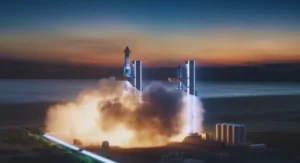Unbelievable Rocket Facts to Blow Your Mind
By TIMEOFINFO
December 28, 2022
Update on : May 15, 2023

NASA and space companies use rockets to launch satellites, and probes or send people to other planets. Here, you can learn some incredible rocket facts that will surprise you. But first facts first. A rocket is a type of space vehicle that works on jet propulsion and accelerates without using the air from the surroundings. Another of the rocket facts is that their engines produce thrust via reaction and work solely on the propellant carried by the vehicle.
So, rockets can fly and operate in space and the vacuum of space. In fact, they are more efficient in the vacuum, losing thrust when the atmosphere pressure opposes them. Multistage carriers can attain escape velocity from our planet, and thus, they can achieve unlimited maximum altitude. Compared with engines that need air, spacecraft launchers are more powerful and lightweight. For flight control, spacecraft uses momentum, auxiliary reaction engines, airfoils, momentum wheels, gimballed thrust, propellant flow, exhaust stream deflection, gravity, or spin.
Who invented first rocket?
The first rocket was invented by an American Dr. Robert Hutchings Goddard, and a German-born Wernher von Braun — a fact few people know about. Dr. Goddard is regarded as the parent of contemporary rocket propulsion. He was a physicist with incredible insight and had a unique genius as far as invention goes. The NASA Goddard Space Flight Center from Greenbelt was built in his memory and established in 1959, on May 1. By 1926, when he was 44, Dr. Goddard had already built and successfully tested his first liquid-fuel rocket. His flight from March 16, 1926, which took place at Auburn, Massachusetts, was very important for humanity.
In fact, Dr. Goddard’s flight was as important as the Wright brothers’ flight from Kitty Hawk. This is one of the rocket history facts anyone should know. First, Goddard’s inventions didn’t make the best impression on the government officials who analysed them. Eventually, Goddard received help from the Daniel Guggenheim Foundation and the Worcester Polytechnic Institute of Clark University.
What are the main parts of a rocket?

Most space launchers have four main parts: nose cone, body, engine, and fins. As a rule, cargo, and payload go into the nose cone. Payloads could be scientific instruments, astronauts, satellites, and sometimes explosives. And carriers also feature a nozzle and a propellant tank. As you can obviously imagine, the propellant tank is the place where the fuel goes. The carrier’s first stage helps the spacecraft escape our planet’s lower atmosphere. Extra side boosters can sometimes be used as well.
Orbital Today mentions that the frame or structural system of any launcher is a lot like an aeroplane’s fuselage. It’s made from lightweight materials that are also very strong. These materials could be aluminium or titanium. They usually employ very long “stringers” that run top to bottom and become connected with “hoops” running around the launcher’s circumference. Then, the carrier’s skin becomes attached to stringers and hoops. This way, carriers get to have a basic shape. This could be one of the most interesting facts about rockets.
How fast can a rocket go?
We couldn’t discuss space rocket facts without mentioning the speed at which most launchers travel. Due to high exhaust velocity, at 9,000 to 16,200 km/h, launchers are especially useful when there’s a need for very high speeds. This type of speed is, in fact, the orbital speed, which is about 28,000 km/h. Launchers should go at very high speeds to leave our planet and reach space since the Earth’s escape velocity is 40,284 km/h.
The fastest man-made space-travelling object ever recorded is NASA’s Juno. This is perhaps one of the most interesting and fun facts about rockets. While approaching Jupiter, Juno flew at 365,000 km/h. As far as the fastest launch velocity goes, this was reached by the New Horizons spacecraft at 58,000 km/h. The speeds mentioned here are of course, relative only to our planet, so we use them to compare some numbers.
What are some fun facts about rockets?
To close this article, let’s mention another 10 facts about rockets. These are:
- Fact #1: The first vehicle to ever reach space was Nazi Germany’s V-2
- Fact #2: The military can use rockets to deliver bombs
- Fact #3: First suggestion of propelling a human into space by using a space vehicle was Rev William Leitch
- Fact #4: Vostok-K 8K72K was the first rocket that sent a human into space
- Fact #5: Sputnik 8K71PS was the first satellite into space on a rocket
- Fact #6: Most successful rocket on launch number was Saturn V, with 13 launches
- Fact #7: It’s very likely that the Chinese invented rocket analogues back around 1200
- Fact #8: Soviet Union launched its first rocket with an animal on board. This animal was a dog named Laika
- Fact #9: Until today, there have been over 220 spacecraft launched by Delta II
- Fact #10: Rockets are the most powerful vehicles in the world today
And there you go — which of these fun rocket facts are most interesting for you?
















